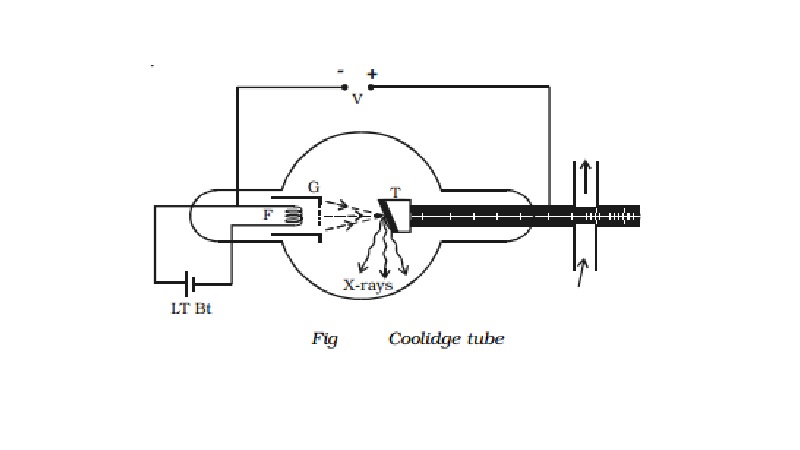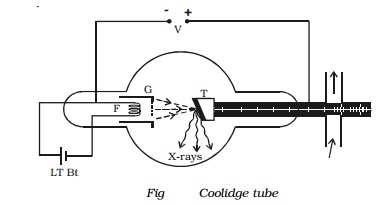Chapter: 11th 12th std standard Class Physics sciense Higher secondary school College Notes
Production of X-rays - Modern Coolidge tube

X-rays
A German scientist, Wilhelm Roentgen, in 1895,
discovered X-rays when he was studying the phenomenon of discharge of
electricity through gases.
After performing a series of experiments,
Roentgen concluded that when a beam of fast moving electrons strike a solid
target, an invisible penetrating radiation is produced. Due to the unknown
nature of the radiation, Roentgen called these radiations as X - rays.
X-rays are electromagnetic waves of short
wavelength in the range of 0.5 Å to 10 Å. Roentgen was awarded Nobel prize in
1901 for the discovery of X-rays.
Production of X-rays - Modern Coolidge tube
X-rays are produced, when fast moving electrons
strike a metal target of suitable material. The basic requirement for the
production of X-rays are: (i) a source of electrons, (ii) effective means of
accelerating the electrons and (iii) a target of suitable material of high
atomic weight.
The modern type of X-ray tube designed by
Coolidge is shown in Fig. It consists of a highly evacuated hard glass bulb
containing a cathode and an anode target. The pressure inside the tube is 10-6
mm of mercury. The cathode is a tungsten filament F and is heated by passing a
current through it from a low tension battery. The electrons are emitted by the
process of thermionic emission from the cathode. The filament is surrounded by
a molybdenum cylinder G kept at a negative potential to the filament. Hence,
the electrons emitted from the filament are collimated into a fine pencil of
electron beam.

The target T consists of a copper block in
which a piece of tungsten or molybdenum is fixed. The anode should have the
following characteristics :
(i)
high
atomic weight - to produce hard X-rays
(ii)
high
melting point - so that it is not melted due to the bombardment of fast moving
electrons, which cause lot of heat generation.
(iii) high thermal conductivity - to carry away the
heat generated.
The face of the copper anode is sloped at about
45o to the electron beam. Being good conductor of heat, copper helps
to conduct the heat efficiently to the water cooling system. A high potential
of about 20 kV is applied between filament F and the target T. Due to this high
potential difference, the electrons emitted from the filament are accelerated.
When these accelerated electrons strike the target, they give up their kinetic
energy and thereby produce X-rays.
The intensity of X-rays depends upon the number
of electrons striking the target. i.e. the rate of emission of electrons from
the filament. This can be controlled by varying the filament current.
Related Topics